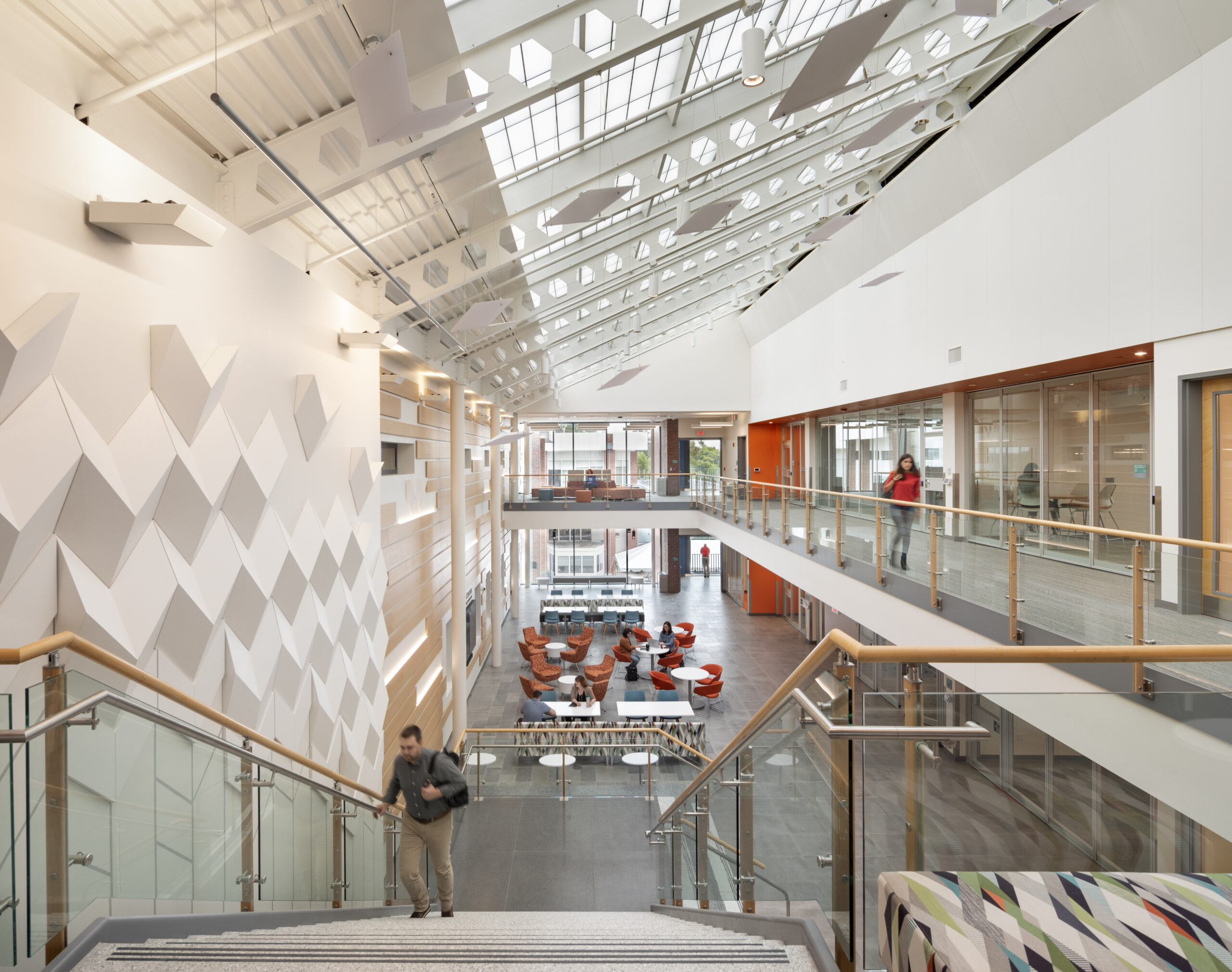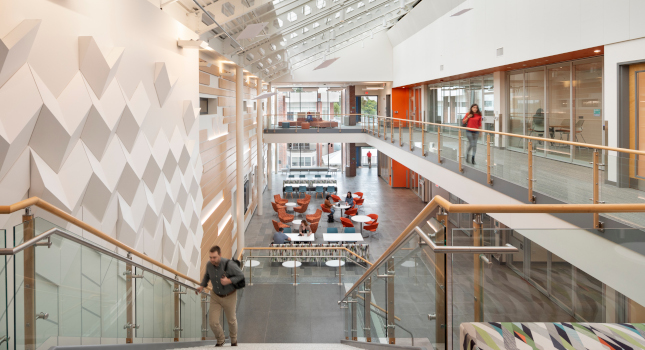Benefits and challenges of increased automation in colleges and universities
College and university buildings are becoming more reliant on technology as a way of teaching and learning, creating new design challenges for engineers.
Automation insights
- Sensors and data analytics are playing a crucial role in automation and control systems for university buildings. They enable predictive maintenance, early issue detection, load management and data-driven decision-making.
- The shift to online or hybrid learning has impacted the design of campus buildings, with a greater emphasis on robust technology systems, expanded wireless access points, enhanced network infrastructure and the integration of audio-visual systems.

September 2023 MEP Roundtable. Courtesy: CFE Media and Technology
Respondents:
- Christopher Augustyn, PE, Senior Project Engineer, Department Facilitator, Affiliated Engineers Inc., Chicago
- Matthew Goss, PE, PMP, LEED AP, CEM, CEA, CDSM, Mechanical, Electrical, Plumbing & Energy Practice Leader, CDM Smith, Latham, New York
- Richard Loveland, PE, Senior Vice President, BVH a Salas O’Brien Company, Bloomfield, Connecticut
- Tom Syvertsen, PE, LEED AP, Vice President, Mueller Associates, Madison, Virginia
- Kristie Tiller, PE, LEED AP, Associate, Director of Mechanical Engineering, Lockwood, Andrews and Newnam Inc. (LAN), Dallas
From your experience, what systems within a college or university project are benefiting from automation that previously might not have been?
Richard Loveland: From my experience, one system within college and university projects in particular that has greatly benefited from automation is lighting controls. With the integration of LED lighting and low voltage control systems, campus facility groups can now program lighting throughout the campus to maximize energy efficiency while ensuring a safe environment for students and staff. Interior lighting has been improved using refined daylighting and occupancy controls. These systems intelligently adjust the lighting levels based on the availability of natural daylight and occupancy in a space, resulting in efficient, yet appropriate, lighting conditions for various areas within the facilities.
Furthermore, automation has revolutionized exterior lighting management. With the use of tablets, facility groups can control and adjust the lighting of outdoor areas from virtually any place on campus. This level of control allows for efficient operation and dimming of exterior lighting, enhancing campus safety and security while conserving energy.
Matthew Goss: We’re seeing more integration of independent controls systems. Specifically, we’re seeing the desire to combine previously independent systems, such as heating, ventilation and air conditioning HVAC, lighting and fire alarms. Additionally, we’re seeing more internet of things (IoT)-enabled devices or more sensors and monitoring points than we have seen in the past. Where at one point in time we may only have received alarms or run status, we may now see temperatures, pressures or percentage open.
How are sensors and data analytics used in automation and control systems for university buildings?
Matthew Goss: You can use sensors and data analytics for many things. Specifically, I’m interested in using them for predictive analytics to support preventative maintenance activities and to help predict early operational issues or equipment failures. That way, problems can be resolved before a critical issue arises and when there is still time to fix or address issues. Additionally, you can use them to track system performance (operating efficiency), early planning (system warmup/cool-down), load management (peak shaving) and load balancing.
Richard Loveland: Overall, the integration of sensors and data analytics empowers facility groups to make data-driven decisions, optimize building performance and enhance energy efficiency in university buildings. All systems in the smart building model can be trended. By utilizing sensors such as thermostats, humidistats, CO2 sensors and occupancy sensors, facility groups can gain a comprehensive understanding of how the building operates and identify trends across different seasons. This information helps in making informed decisions related to energy conservation measures, maintenance scheduling and operational adjustments.

Salas O’Brien worked on the University of New Haven’s Bergami Center for Science, Technology, and Innovation, which features collaborative classrooms, huddle spaces, a teaching auditorium that functions as a cinema, a live broadcast studio and a makerspace. Courtesy: Robert Benson Photography, Salas O’Brien
What types of system integration and/or interoperability issues have you overcome for these projects and how did you do so?
Richard Loveland: One challenge we have overcome in these projects is the integration and interoperability between lighting control and building management systems or automatic temperature control systems. To address this, we keep these systems separate to minimize complexity. This allows for easier troubleshooting and support, with facility groups contacting the specific vendors for assistance. By maintaining independent systems, we ensure system stability and simplicity, while still addressing the needs of each system.
Matthew Goss: Recently, we’ve been working to overcome issues with multiple existing systems that operate on different platforms. As such, we’ve been working to design replacements of various independent systems and bring them under a single operating system or network. We’ve also been addressing issues of mixed technology type — specifically mixes of digital and pneumatic systems. For better or worse, this typically involves the replacement and/or upgrade of pneumatic equipment.
Has IoT come up in discussion or been implemented on such projects? How has this integration impacted the project? If so, please give an example.
Richard Loveland: Most devices or systems with sensors that are operable through a computer interface can be categorized as part of the IoT. The IoT refers to the network of interconnected physical devices or things embedded with sensors, software, and connectivity that enables them to collect and exchange data over the internet, which includes building management and automation systems.
Cybersecurity and vulnerability are increasing concerns. How are you responding to these concerns?
Matthew Goss: We are responding to these concerns through the utilization of our cybersecurity team. Our independent cybersecurity group is available to provide design and review services on projects. In addition, our teams work hand in hand with client teams to make sure that client-specific requirements are being met and achieved.
Richard Loveland: It’s true that building systems, which are frequently less secure than IT networks, can be intentionally manipulated or disabled through connections that exist outside of an organization’s network. Salas O’Brien has teams that provide assessments, audits and testing, systems design and implementation, commissioning and continuous monitoring services for the cybersecurity of building systems.
How has bring your own device affected the design of technology systems in campus buildings? How has a shift to online or hybrid learning impacted the design of campus buildings?
Richard Loveland: The shift to bring your own device has led to an increased focus on expanded wireless access point coverage in campus buildings. Adequate capacity and coverage are essential to accommodate the growing number of wireless users. Factors considered in designing the wireless system include construction type, occupancy, device spacing and device elevations.
The shift to online or hybrid learning has emphasized the need for robust technology systems. Design considerations now prioritize enhanced network infrastructure, expanded bandwidth and integration of audio-visual systems and collaboration tools to support effective online teaching and learning experiences.
How has your technology team worked with facility managers to implement security technology (biometrics, card-scan, etc.) in college and university projects?
Richard Loveland: Salas O’Brien has an extensive team of physical security designers that can work with university security teams and design access control, video surveillance and intrusion detection.
Do you have experience and expertise with the topics mentioned in this content? You should consider contributing to our CFE Media editorial team and getting the recognition you and your company deserve. Click here to start this process.

